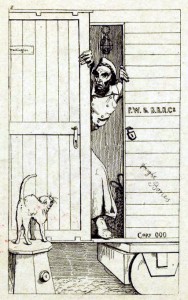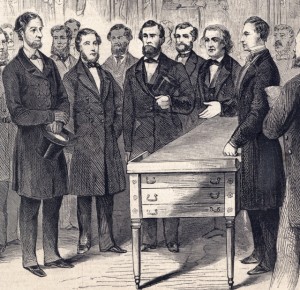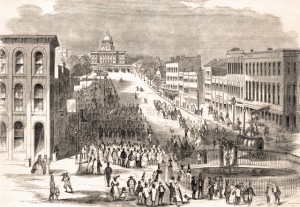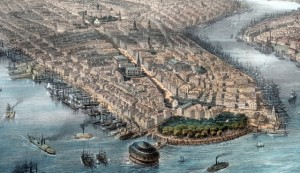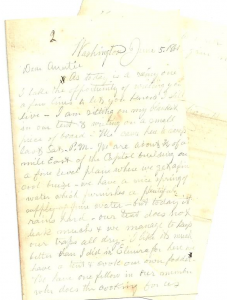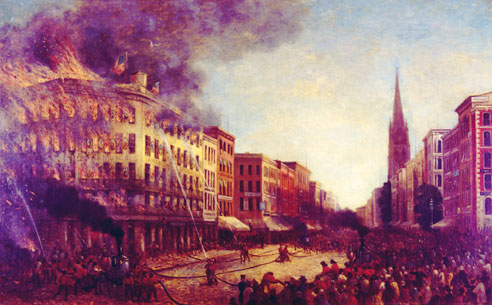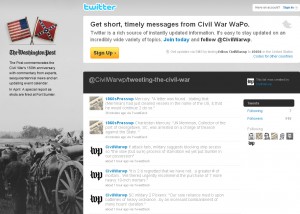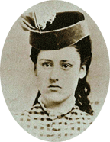
Just 150 years ago today on Saturday afternoon, February 16, 1861, President-Elect Abraham Lincoln met twelve-year-old Grace Bedell on a train platform in Westfield, New York. Showing off his new facial hair, he kissed the young girl and reportedly said, ““You see I have let these whiskers grow for you, Grace.”
If you know this story, then you’re either a Civil War buff or a very attentive sixth-grader. The year before Grace Bedell had written presidential candidate Abe Lincoln (whom she addressed as “Hon. A.B. Lincoln”) in October 1860 from her family’s temporary residence in upstate New York, inquiring whether Lincoln had any daughters before urging him to “let your whisker grow” since “your face is so thin.” This is a charming story that many elementary school teachers describe in their classrooms because it conveys such an important message about empowerment. Young Grace had an endearing, childlike candor (“answer this letter right off” she wrote in closing) that apparently ignited the bored candidate’s fancy because he responded within days. “I regret the necessity of saying I have no daughters,” Lincoln replied, adding, “As to the whiskers, having never worn any, do you not think people would call it a piece of silly affectation if I were to begin it now?” The famous letters, however, have never before been exhibited in public until 2009 when they were brought together by the Library of Congress in an exhibition that is currently traveling around the country.
In Lincoln’s era, presidential candidates almost always stayed home and avoided making public statements. It was considered undignified and un-republican to seek the presidential office. Obviously a few things have changed, but at least one political truth has endured. Image mattered just as much then as now.
Most school children hear this much of the Lincoln-Bedell story at least once during their academic careers, and every Lincoln scholar knows about it. But until recently, nobody really believed there was any more to the relationship. After the war, Grace Bedell married a Union army veteran named George Billings. The couple moved to Kansas and forged a life on the western prairie. They had one son and no daughters. Every so often until her death in 1936, Grace Bedell Billings would make an appearance, consent to an interview, or respond to some new correspondent seeking details about her encounter with Lincoln. Yet the gun-toting homesteader seemed mostly indifferent to her recurring fifteen minutes of fame. Grandson George Billings wrote to Time magazine shortly after her death, thanking the editors for orchestrating a dramatization about her experience with Lincoln, and claiming credibly that one of her favorite expressions had always been, “I dislike making a fuss.” Today, Billings descendants are trying to raise funds to preserve her former home in Delphos, Kansas.
This effort received a boost in 2007 when a diligent Lincoln researcher named Karen Needles discovered a new letter from Grace Bedell to President Lincoln that was written in January 1864 and somehow had gotten overlooked in the voluminous files of the National Archives. “Do you remember before your election receiving a letter from a little girl residing at Westfield in Chautauqua Co. advising the wearing of whiskers as an improvement to your face,” Bedell asked, before informing the president in firm, clear handwriting, “I am that little girl grown to the size of a woman.” Young Grace had grown but her characteristic brashness remained. Reminding the president that he had signed his previous letter to her, “Your true friend and well-wisher,” Bedell asked, “Will you not show yourself my friend now?” It turned out that she wanted a job, but her reason was quite poignant. “My Father during the last few years lost nearly all his property,” she confided, “and although we have never known want, I feel that I ought and could do something for myself.” She had heard about “a large number of girls” who were “employed constantly and with good wages at Washington cutting Treasury notes and other things pertaining to that Department.” She wondered, “Could I not obtain a situation there?” The appeal closed by noting that her parents were “ignorant of this application” and gently pointing out that she had sent an earlier query to him that had gone unanswered. “Direct to this place” was the line that closed Grace Bedell’s third letter to Abraham Lincoln.
She never heard back from the president and never once mentioned this application in any of her post-war accounts. Yet there is some reason to believe that President Lincoln did respond to Grace’s request by writing to her parents directly. There have been many children’s books written about Grace Bedell, and most are inconsequential, but there has been one serious historical account produced by Fred Trump, a native of Westfield who ended up settling in Salina, Kansas, not far from the Billings farm in Delphos. That coincidence apparently drove Trump, a retired Department of Agriculture official, to prodigious effort in his research. He turned up many local accounts that appear nowhere else but in his 1977 book, Lincoln’s Little Girl.
Toward the end of his book, Trump relates how some members of the Bedell family claimed that President Lincoln tried to adopt Grace during the war. The author quoted from multiple accounts produced by a woman named Jennie Macomber, who had been a little girl herself in Westfield in 1860 and who later befriended members of the Bedell family. She recalled how they told her that the president had written Grace’s father during the war “and offered to adopt her as his own daughter.” Trump believed Macomber’s story, and corroborated it as much as he could, but also dutifully quoted several Lincoln experts who coolly dismissed the tale as “embroidery.” The late Roy P. Basler, editor of Lincoln’s Collected Works, informed Trump, “The Abraham Lincoln papers include no correspondence between Lincoln and the parents of Grace Bedell. The collections in this division are not known to contain any information corroborating this story.”
That was in 1977. But in 2007, there appeared this newly discovered letter that does offer at least some corroboration of the old family gossip. After reading the 1864 letter from Grace, it is easy to imagine that Abraham Lincoln responded to the story of the Bedell family’s financial struggles with a direct appeal to Grace’s father. The president might well have offered to have the young woman live in the White House while she worked as one of the war’s many Treasury Department girls. Too proud to admit his financial reversals, businessman Norman Bedell either declined or just ignored the unexpected offer. What seemed fanciful to Roy Basler, now appears more reasonable given this new letter. Of course, the irony is that like so much else in history, with more information, our certainty about the past suddenly seems far less secure.
